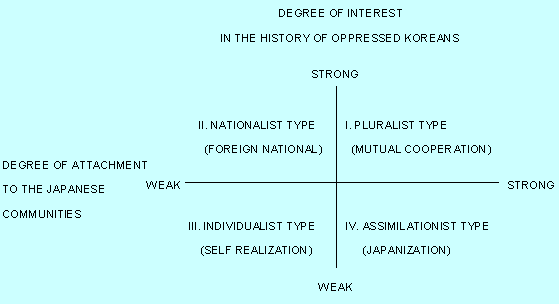 The
zainichi Koreans are those with a Japanese upbringing and who were born
in Japan. They are the largest ethnic group in Japan. Many of the Koreans in
Japan live in the Kansai plain surrounding the city of Osaka.
The
zainichi Koreans are those with a Japanese upbringing and who were born
in Japan. They are the largest ethnic group in Japan. Many of the Koreans in
Japan live in the Kansai plain surrounding the city of Osaka. The
zainichi Koreans are those with a Japanese upbringing and who were born
in Japan. They are the largest ethnic group in Japan. Many of the Koreans in
Japan live in the Kansai plain surrounding the city of Osaka.
The
zainichi Koreans are those with a Japanese upbringing and who were born
in Japan. They are the largest ethnic group in Japan. Many of the Koreans in
Japan live in the Kansai plain surrounding the city of Osaka.
This community dates back to the end of the 19th century. Since the Meiji Restoration (1868) Koreans have suffered oppression from the Japanese by colonialism. In the period when Japan occupied the Korean Peninsula before and during World War II, many Koreans were brought to Japan as forced labour to replace the Japanese men who had joined the army. Of the roughly four million Koreans transported to Japan to serve as industrial labourers without pay in colonial times, a half-million remained in Japan. During World War II Koreans were expected to work without pay, and afterwards when they were paid it was for a lesser sum than a Japanese worker would earn.
When Japan lost the war, Koreans theoretically became free people because the Japanese government did not want to give them reparations. The government effectively wanted them to leave Japan and did not want to recognise them as a group of people who have the right to live in Japan.
For a long time, Koreans suffered oppression from the Japanese and the forced acculturation of Koreans into Japanese society has resulted in destruction of their Korean identity. This has lead to an 'internalised' Japanese culture being adopted by these Koreans. As the population of younger zainichi Koreans increases, their lives have become much more integrated into Japanese society and they have fewer chances of being accustomed with Korean culture. This can create inferiority complexes about Korean ethnicity mainly due to racial discrimination in the formative years of youth.
However, aspects of the Korean culture have survived and do flourish. The existence of Korean temples in Japan provides the Korean minority with an alternative to Japanese religious institutions and this reverses the usual hierarchy in which Koreans defer to the Japanese. The temples form the Korean minority's social life, and they exclude the Japanese so that in temple worship Koreans can act entirely independently of the Japanese. The assimilation of Koreans into the Japanese mainstream is resisted in this way.
Similarly, Koreans in Japan have established other separate institutions, including schools from elementary to university level, and financial institutions and other enterprises. The United Nations Sub-Commission on the Promotion and Protection of Human Rights in August 2001 has also urged the Japanese government to officially recognise minority schools, in particular Korean schools, and to assist them by way of subsidies and financial help. The UN body also stated that Japan must recognise graduate certificates from Korean schools - all of which already adhere to the Japanese educational system and curriculum - for Japanese university entrance purposes.
Koreans have been unfairly treated in Japan, even if a person's family has lived in Japan for generations. Discrimination continued even after the Japanese domination of their homeland ended. Koreans were regarded as second class citizens. They faced considerable discrimination in education, employment and housing prospects. Intermarriage is not encouraged by the Japanese. There is an ill conceived view by some Japanese that Koreans are only foreigners who will eventually leave.
In the past it was difficult for Koreans to achieve white-collar status. Now they are represented in the academic and other professions, and even in the membership of the Liberal Democratic Party which is the prevailing political party in Japan. Japanese society today discriminates much less against Koreans and there has been a tendency recently for Koreans to simply to call themselves 'Koreans living in Japan'. Those seeking Japanese citizenship are no longer trying to hide their Korean identity but simply choosing to live as 'Korean Japanese' for practical purposes.
Click here to read the interview Informing Ignorance, Erasing Shame by Lee Yumi a Korean Human Rights Activist in Japan.
Yasunori Fukuoka and Yukiko Tsujiyama describe Koreans in Japan as falling into 4 types. Click this link to read their article called MINTOHREN: Young Koreans Against Ethnic Discrimination in Japan.